Carbon Dioxide (CO2) Lasers Information
Carbon dioxide lasers are gas lasers which emit infrared radiation. They are used for a variety of high power industrial applications. As discussed in the Lasers Selection Guide, all lasers consist of three components: an energy source (also known as a pump), a gain (or laser) medium, and an optical resonator. These components are labeled in the diagram below. The pump serves to provide energy which is amplified by the gain medium. This energy is eventually converted into light and is reflected through the optical resonator which then emits the final output beam.
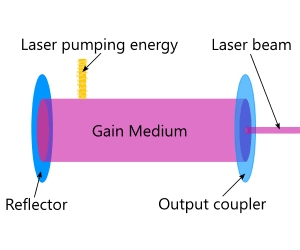
Image credit: EnlightenYourMind
All gas lasers rely on the excitation of gases to amplify energy; considering the image above, the gas functions as the laser medium. Carbon dioxide lasers in particular are comprised of the following components:
- Electrical current — serving as the laser pump — which excites the gas medium.
- A mixture of gases — serving as the gain medium — comprised of carbon dioxide, nitrogen, hydrogen, an
 d helium. The carbon dioxide, nitrogen, and helium make up the vast majority of the mixture, although the specific concentrations vary depending on the laser's intended use. Typical gas mixtures have an N2:CO2:He ratio of 1:1:8.
d helium. The carbon dioxide, nitrogen, and helium make up the vast majority of the mixture, although the specific concentrations vary depending on the laser's intended use. Typical gas mixtures have an N2:CO2:He ratio of 1:1:8. - A specialized optical resonator. Because CO2 lasers operate solely within the infrared spectrum and can attain high power outputs, their optical components are typically made of specialized (and often expensive) materials such as germanium, zinc selenide, silver, gold, and diamond.
When electrical current is introduced to the gain medium, the nitrogen molecules are excited to a vibrational state. Because these molecules are comprised solely of nitrogen, they will retain this vibrational energy for long periods. Next, the vibrating nitrogen molecules excite the carbon dioxide molecules, to the point that the gain medium becomes an effective amplifier for the pumped energy. As the nitrogen molecules come into contact with cold helium atoms, they gradually become less excited and transfer energy to the helium in the form of heat. The hot helium atoms must then be cooled to maintain a population inversion (a sufficient difference between excited and lower energy atoms to produce optical gain) with the excited carbon dioxide atoms. These processes are illustrated in the graph below.
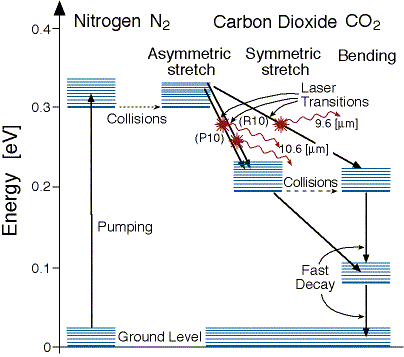
Image credit: Kansas State University
The image below shows a typical CO2 laser system. In this image, the power panel, transformer, and rectifier provide electrical current as the pump, while the tank in the center feeds the gas mixture into the laser. The water pump system provides cooling for the sides of the laser, so that hot helium atoms become less excited when they collide with the water-cooled walls.
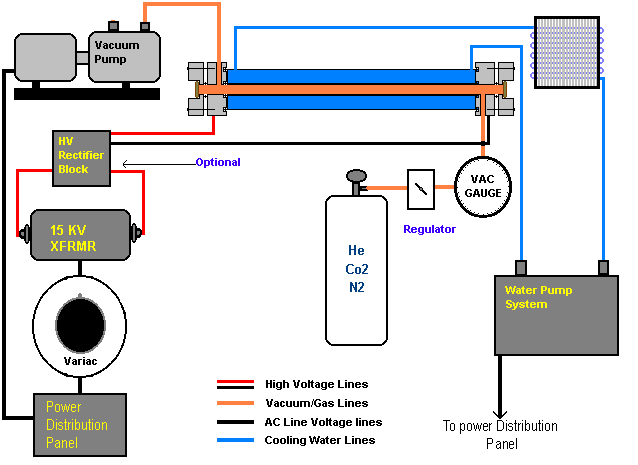
Image credit: Jon's Lasers
Applications
CO2 lasers feature many characteristics which make them ideally suited to industrial and materials processing applications. Some of the attributes include:
- Low cost in relation to power capabilities (often less than $100 per watt)
- High efficiency (output to pump ratio of up to 20%)
- Wide possible variation in output power
- Long lifetime
- Many possible output waveforms
- Minute alterations in gas concentration allows for the possibility of selecting from hundreds of discrete infrared wavelengths
Carbon dioxide lasers are most frequently used in laser cutting and welding, or — for lower power devices — laser engraving and marking. Also, because water (which makes up the majority of biological tissues) absorbs infrared radiation well, CO2 lasers are used in medical applications such as laser surgery, skin resurfacing, dermabrasion, and more recently to "weld" human tissue in place of sutures.
The video below shows a 250-watt computer numerical control (CNC) CO2 laser cutting sheet metal.
Video credit: Owen White
Specifications
Wavelength
Compared to other lasers, CO2 lasers are confined to a relatively small range of wavelengths occurring exclusively within the infrared (IR) spectrum. Carbon dioxide lasers almost always emit light within the 9.4 μm to 10.6 μm band, which corresponds to roughly 28.3 terahertz (THz) to 31.9 THz. As mentioned above, the ability to vary gas concentrations within the gain medium enables CO2 lasers to be manufactured to emit precise discrete frequencies within its general range.
Output Power
CO2 lasers are typically provided with an output power rating by the manufacturer. They are often classified as high power devices, with some emitting continuous 60 kW (6000 W) beams. A laser's power typically determines its application; for example, a high power laser is most suitable for cutting and welding, while a lower power device can be used for marking of barcodes and labels.
Safety
Laser safety is an important topic when discussing use of carbon dioxide lasers due to their high power capabilities. Even a split-second direct exposure to a 200 mW laser emitting 100 yards away can cause permanent eye damage; considering that a CO2 laser may emit thousands of watts of power at a close distance, direct contact may instantaneously burn an operator's eyes or skin.
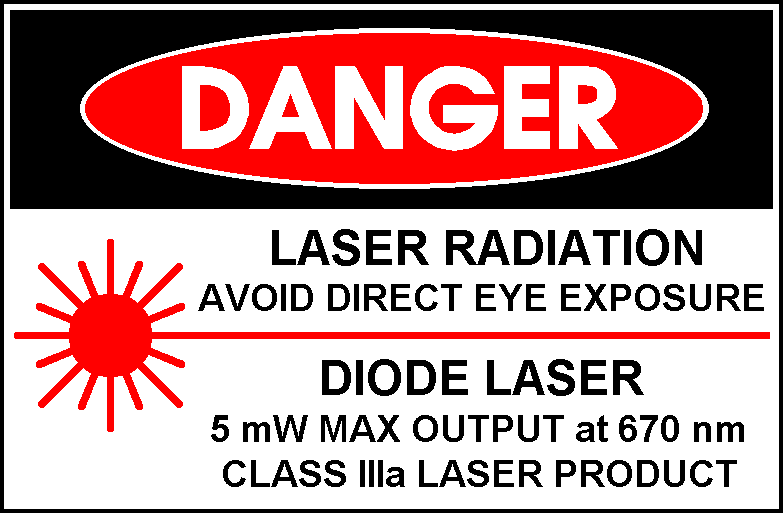
A laser warning sign, including specs and class. Image credit: Keller Studio
To address the concerns above, the Center for Devices and Radiological Health (CDRH) — a division of the US Food and Drug Administration (FDA) — provides a laser safety classification scheme based on six product classes. Lasers are also specified by different classes described in the international IEC 60825 standard. The table below describes both US domestic and international classes for laser safety; most CO2 lasers qualify as Class 4 devices.
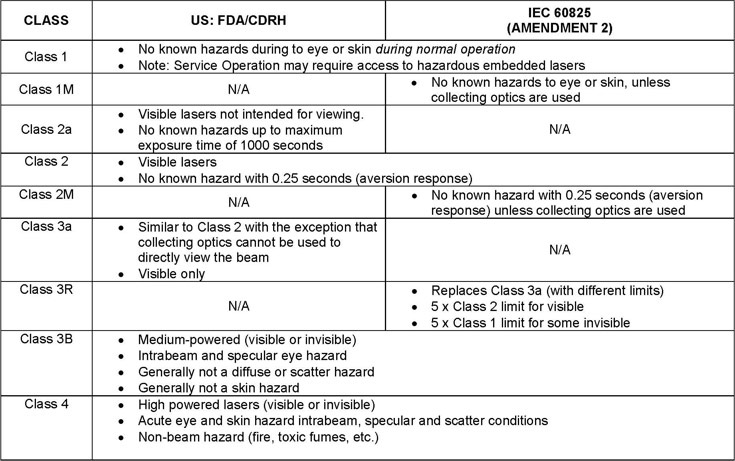
Laser safety classes. Image credit: Erchonia
References
Columbia University - Common industrial lasers
Sam's Laser FAQ - Carbon Dioxide Lasers
SPIE - CO2 Lasers
Image credit:
Synrad
- carbon dioxide laser
- CO2 laser IR detector
- attenuator CO2 laser
- CO2 snow gun manufacturers
- high power IR emitters
- industrial CO2 lasers
- IR LED CO2
- tea CO2 lasers
- tunable CO2 laser
- waveguide CO2 laser
- 100w CO2 lasers
- 30w CO2 lasers
- coherent 50w CO2 lasers
- handheld CO2 lasers
- high power CO2 lasers
- sealed RF excited CO2 lasers
- universal laser systems CO2 lasers
- variable attenuator CO2 lasers
- wood cutting CO2 lasers
